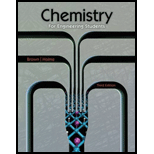
Interpretation:
Concept introduction:
Every reaction has activation energy. To overcome this energy sometimes we should provide energy from outside. But for some reactions, we do not have to supply energy. Ambient temperature is enough that reactions. Those reactions are called spontaneous reactions.
Two methods can be used to find out the activation energy of a reaction when the rate constants at two or more temperatures are known.
- Two point method by solving simultaneous equations (If rate constants are known only for two temperatures
- Graphical method where activation energy can be obtained using the gradient of the graph (When rate constants for more than two temperatures are known)
Answer to Problem 11.59PAE
Solution:
Given:
Chemical reaction
|
|
Temperature/K |
|
|
2000 |
|
|
3000 |
|
|
4000 |
Explanation of Solution
- The rate of the equation for the reaction can be written as follows.
- The only equation relating activation energy and rate constant is Arrhenius equation which is given below. The frequency factor doesn’t depend on the temperature.

It can be written as
Therefore at two different temperatures at
When equation 1 is subtracted from equation 2,
Formula used:
Calculation:
Want to see more full solutions like this?
Chapter 11 Solutions
Chemistry for Engineering Students
- The reaction NO(g) + O,(g) — NO,(g) + 0(g) plays a role in the formation of nitrogen dioxide in automobile engines. Suppose that a series of experiments measured the rate of this reaction at 500 K and produced the following data; [NO] (mol L ’) [OJ (mol L 1) Rate = -A[NO]/Af (mol L_1 s-1) 0.002 0.005 8.0 X 10"'7 0.002 0.010 1.6 X 10-'6 0.006 0.005 2.4 X IO-'6 Derive a rate law for the reaction and determine the value of the rate constant.arrow_forward11.35 For the reaction 2 NO(g) + 2 H?(g) — N,(g) + 2 H,O(g) at 1100°C, the following data have been obtained: [NOJ [HJ Rate = A(N2]/At (mol L~1) (mol L_1) (mol L-1 s_1) 5.0 X 10’1 0.32 0.012 1.0 X 10~’ 0.32 0.048 1.0 X 10"2 0.64 0.096 Derive a rate law for the reaction and determine the value of the rate constant.arrow_forwardThe following rate constants were obtained in an experiment in which the decomposition of gaseous N2O; was studied as a function of temperature. The products were NO, and NO,. Temperature (K) 3.5 x 10_i 298 2.2 x 10"4 308 6.8 X IO-4 318 3.1 x 10 1 328 Determine Etfor this reaction in kj/mol.arrow_forward
- The reaction for the Haber process, the industrial production of ammonia, is N2(g)+3H2(g)2NH3(g) Assume that under certain laboratory conditions ammonia is produced at the rate of 6.29 ×10-5 molL-1s-1. At what rate is nitrogen consumed? At what rate is hydrogen consumed?arrow_forwardOne of the concerns about the use of Freons is that they will migrate to the upper atmosphere, where chlorine atoms can be generated by the following reaction: CCl2F2(g)Freon-12hvCF2Cl(g)+Cl(g) Chlorine atoms can act as a catalyst for the destruction of ozone. The activation energy for the reaction Cl(g) + O3(g) ClO(g) + O2(g) Is 2.1 kJ/mol. Which is the more effective catalyst for the destruction of ozone, Cl or NO? (See Exercise 75.)arrow_forward11.44 A possible reaction for the degradation of the pesticide DDT to a less harmful compound was simulated in the laboratory. The reaction was found to be first order, with k = 4.0 X 10_H s"' at 25°C. What is the half-life for the degradation of DDT in this experiment, in years?arrow_forward
 Chemistry for Engineering StudentsChemistryISBN:9781337398909Author:Lawrence S. Brown, Tom HolmePublisher:Cengage Learning
Chemistry for Engineering StudentsChemistryISBN:9781337398909Author:Lawrence S. Brown, Tom HolmePublisher:Cengage Learning Principles of Modern ChemistryChemistryISBN:9781305079113Author:David W. Oxtoby, H. Pat Gillis, Laurie J. ButlerPublisher:Cengage Learning
Principles of Modern ChemistryChemistryISBN:9781305079113Author:David W. Oxtoby, H. Pat Gillis, Laurie J. ButlerPublisher:Cengage Learning
 Chemistry: An Atoms First ApproachChemistryISBN:9781305079243Author:Steven S. Zumdahl, Susan A. ZumdahlPublisher:Cengage Learning
Chemistry: An Atoms First ApproachChemistryISBN:9781305079243Author:Steven S. Zumdahl, Susan A. ZumdahlPublisher:Cengage Learning ChemistryChemistryISBN:9781305957404Author:Steven S. Zumdahl, Susan A. Zumdahl, Donald J. DeCostePublisher:Cengage Learning
ChemistryChemistryISBN:9781305957404Author:Steven S. Zumdahl, Susan A. Zumdahl, Donald J. DeCostePublisher:Cengage Learning General Chemistry - Standalone book (MindTap Cour...ChemistryISBN:9781305580343Author:Steven D. Gammon, Ebbing, Darrell Ebbing, Steven D., Darrell; Gammon, Darrell Ebbing; Steven D. Gammon, Darrell D.; Gammon, Ebbing; Steven D. Gammon; DarrellPublisher:Cengage Learning
General Chemistry - Standalone book (MindTap Cour...ChemistryISBN:9781305580343Author:Steven D. Gammon, Ebbing, Darrell Ebbing, Steven D., Darrell; Gammon, Darrell Ebbing; Steven D. Gammon, Darrell D.; Gammon, Ebbing; Steven D. Gammon; DarrellPublisher:Cengage Learning





